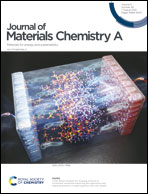A universal strategy towards 3D printable nanomaterial inks for superior cellular high-loading battery electrodes†
Abstract
Direct ink writing has emerged as one of the simplest 3D printing technologies for a wide range of applications including energy storage devices. Inks with high printability and desired functionality are the most important elements to achieve efficient 3D printing. Many printable inks have been reported; however, few were developed with high versality. In this paper, a versatile fabrication approach for various desirable 3D printable nanomaterial inks is presented for superior battery electrodes. By controlling the dispersing solvents, the inks' rheological properties are well tailored for 3D printing processes without sacrificing the weight ratio of electrode components. At high mass loading, 3D printed cellular LiFePO4 cathodes and Li4Ti5O12 anodes deliver high specific capacities of 168 (0.5C) and 171 mA h g−1 (1C), respectively, which are both close to their corresponding theoretical capacities. Meanwhile, high-rate capabilities and superior long-term cycling stabilities are also demonstrated for the obtained cellular high-loading cathodes and anodes. A 3D printed Li-ion full-cell battery also exhibits outstanding electrochemical performance. This work presents a strategy with high versality for advanced 3D printable nanomaterial inks for next-generation customized and high-performance energy storage devices.



 Please wait while we load your content...
Please wait while we load your content...